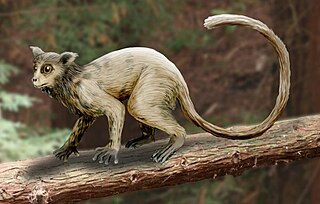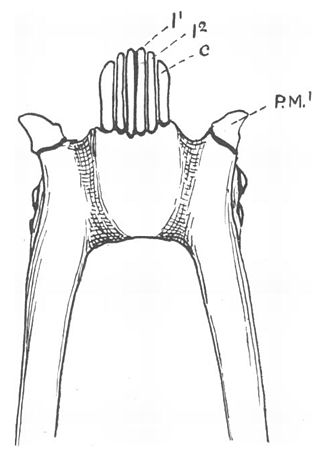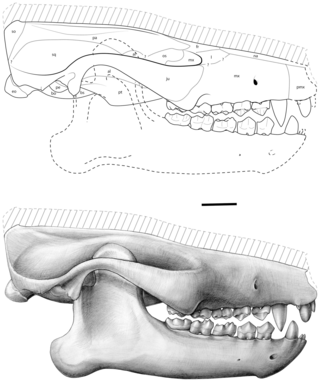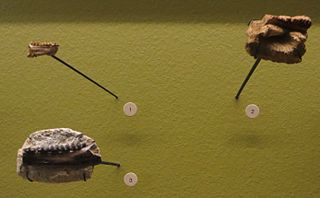
Andrewsarchus, meaning "Andrews' ruler", is an extinct genus of artiodactyl that lived during the Middle Eocene in what is now China. The genus was first described by Henry Fairfield Osborn in 1924 with the type species A. mongoliensis based on a largely complete cranium. A second species, A. crassum, was described in 1977 based on teeth. A mandible, formerly described as Paratriisodon, does probably belong to Andrewsarchus as well. The genus has been historically placed in the families Mesonychidae or Arctocyonidae, or was considered to be a close relative of whales. It is now regarded as the sole member of its own family, Andrewsarchidae, and may have been related to entelodonts. Fossils of Andrewsarchus have been recovered from the Middle Eocene Irdin Manha, Lushi, and Dongjun Formations of Inner Mongolia, each dated to the Irdinmanhan Asian land mammal age.

Dorudon ("spear-tooth") is a genus of extinct basilosaurid ancient whales that lived alongside Basilosaurus 40.4 to 33.9 million years ago in the Eocene. It was a small whale, with D. atrox measuring 5 metres (16 ft) long and weighing 1–2.2 metric tons. Dorudon lived in warm seas around the world and fed on small fish and mollusks. Fossils have been found along the former shorelines of the Tethys Sea in present-day Egypt and Pakistan, as well as in the United States, New Zealand and Western Sahara.

Plesiadapis is one of the oldest known primate-like mammal genera which existed about 58–55 million years ago in North America and Europe. Plesiadapis means "near-Adapis", which is a reference to the adapiform primate of the Eocene period, Adapis. Plesiadapis tricuspidens, the type specimen, is named after the three cusps present on its upper incisors.
Branisella is an extinct genus of New World monkey from the Salla Formation of what is now Bolivia during the Late Oligocene, approximately 26 million years ago (Deseadan), comprising only the species Branisella boliviana. Together with the Peruvian genus Canaanimico, it is the oldest fossil New World monkey discovered.

Necrolemur is a small bodied omomyid with body mass estimations ranging from 114–346 g (4.0–12.2 oz). Necrolemur’s teeth feature broad basins and blunt cusps, suggesting their diet consisted of mostly soft fruit, though examination of microwear patterns suggests that populations from lower latitudes also consumed insects and gums.
Shoshonius is an extinct genus of omomyid primate that lived during the Eocene. Specimens identified as Shoshonius have been found exclusively in central Wyoming and the genus currently includes two species, Shoshonius cooperi, described by Granger in 1910, and Shoshonius bowni, described by Honey in 1990.

Pelycodus is an extinct genus of adapiform primate that lived during the early Eocene (Wasatchian) period in Europe and North America, particularly Wyoming and New Mexico. It is very closely related to Cantius and may even be its subgenus. It may also have given rise to the Middle Eocene Uintan primate Hesperolemur, although this is controversial. From mass estimates based on the first molar, the two species, P. jarrovii and P. danielsae, weighed 4.5 kg and 6.3 kg respectively and were frugivores with an arboreal, quadrupedal locomotion.

A toothcomb is a dental structure found in some mammals, comprising a group of front teeth arranged in a manner that facilitates grooming, similar to a hair comb. The toothcomb occurs in lemuriform primates, treeshrews, colugos, hyraxes, and some African antelopes. The structures evolved independently in different types of mammals through convergent evolution and vary both in dental composition and structure. In most mammals the comb is formed by a group of teeth with fine spaces between them. The toothcombs in most mammals include incisors only, while in lemuriform primates they include incisors and canine teeth that tilt forward at the front of the lower jaw, followed by a canine-shaped first premolar. The toothcombs of colugos and hyraxes take a different form with the individual incisors being serrated, providing multiple tines per tooth.
Rooneyia viejaensis is a relatively small primate belonging to the extinct monotypic genus Rooneyia. Rooneyia viejaensis is known from the North American Eocene of the Sierra Vieja of West Texas; the species is only known from the type specimen. The lack of additional fossils at this time makes it difficult to hypothesize where and how Rooneyia may have evolved. The minimal wear upon the molar teeth of the specimen has led to the assumption that the type specimen is that of a young adult. Rooneyia does not consistently fall within any one group of fossil or extant primates.
Duerotherium is an extinct genus of Palaeogene artiodactyls known only from the Iberian Peninsula during the Middle Eocene, which contains one species D. sudrei. It, like other members of the Anoplotheriidae, was endemic to Western Europe. The anoplotheriine was described from a left fragment of a maxilla from the Mazaterón Formation of the Duero Basin in 2009. Its dentition is mostly typical of the Anoplotheriinae but differs by an elongated plus triangular 3rd upper premolar and very specific traits of the molars. It is thought to have been part of an endemic faunal assemblage that evolved within the Iberian Peninsula by the Middle Eocene, where climates were subtropical.
Djebelemur is an extinct genus of early strepsirrhine primate from the late early or early middle Eocene period from the Chambi locality in Tunisia. Although they probably lacked a toothcomb, a specialized dental structure found in living lemuriforms, they are thought to be a related stem group. The one recognized species, Djebelemur martinezi, was very small, approximately 100 g (3.5 oz).
Plesiopithecus is an extinct genus of early strepsirrhine primate from the late Eocene.

Ocepeia is an extinct genus of afrotherian mammal that lived in present-day Morocco during the middle Paleocene epoch, approximately 60 million years ago. First named and described in 2001, the type species is O. daouiensis from the Selandian stage of Morocco's Ouled Abdoun Basin. A second, larger species, O. grandis, is known from the Thanetian, a slightly younger stage in the same area. In life, the two species are estimated to have weighed about 3.5 kg (7.7 lb) and 10 kg (22 lb), respectively, and are believed to have been specialized leaf-eaters. The fossil skulls of Ocepeia are the oldest known afrotherian skulls, and the best-known of any Paleocene mammal in Africa.
Sivaladapis is a genus of adapiform primate that lived in Asia during the middle Miocene.
Microsyops is a plesiadapiform primate found in Middle Eocene in North America. It is in the family Microsyopidae, a plesiadapiform family characterized by distinctive lanceolate lower first incisors. It appears to have had a more developed sense of smell than other early primates. It is believed to have eaten fruit, and its fossils show the oldest known dental cavities in a mammal.

Dichodon is an extinct genus of Palaeogene artiodactyls belonging to the family Xiphodontidae. It was endemic to Western Europe and lived from the middle Eocene up to the earliest Oligocene. The genus was first erected by the British naturalist Richard Owen in 1848 based on dental remains from the fossil beds in Hordle, England. He noticed similar dentitions to contemporary artiodactyls like those of the Anoplotheriidae and Dichobunidae and references the name of the genus Dichobune. Eventually, it was found to be more closely related to Xiphodon and now includes 11 species, although one of them may be synonymous.

Gypsonictops is an extinct genus of leptictidan mammals of the family Gypsonictopidae, which was described in 1927 by George Gaylord Simpson. Species in this genus were small mammals and the first representatives of the order Leptictida, that appeared during the Upper Cretaceous.
Navajovius is an extinct genus of plesiadapiforms that lived during the Paleocene epoch. Plesiadapiforms were small, arboreal mammals that are theorized to be either closely related to primates or dermopterans. Navajovius has only been documented from localities within North America. This genus was officially named in 1921 by Walter Granger and William Matthew and the type specimen is housed at the American Museum of Natural History.
Archaeopithecus is an extinct genus of notoungulate, belonging to the suborder Typotheria. It lived during the Middle Eocene, in what is today Argentina.
Palaeohodites is an extinct genus of primate from the Eocene Nadu Formation of China. Living about 35 million years ago during the late Eocene, Palaeohodites belongs to an extinct group of primates known as adapiforms, related to modern day lemurs and lorises. Specifically, this genus is one member of the family Ekgmowechashalidae, known primarily from the Eocene and Oligocene of Asia. Notably, Palaeohodites has been recovered as the sister taxon of Ekgmowechashala, the latest primate known to exist in North America before the arrival of humans at the end of the Pleistocene.













